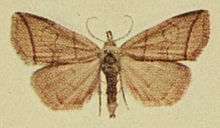Pechipogo strigilata
Pechipogo strigilata, the common fan-foot, is a moth of the family Noctuidae. It was described by Linnaeus in 1758. It is found throughout Europe to the Urals then east across the Palearctic to Siberia, Amur, Ussuri, Korea and Japan.[1][2][3]
| Common fan-foot | |
|---|---|
 | |
| Scientific classification | |
| Kingdom: | |
| Phylum: | |
| Class: | |
| Order: | |
| Family: | |
| Genus: | |
| Species: | P. strigilata |
| Binomial name | |
| Pechipogo strigilata | |
| Synonyms | |
| |
Technical description and variation
The wingspan is 30–35 millimetres (1.2–1.4 in).:[2] Forewing ochreous dusted very densely with yellow brown;a slight dark cell mark; inner and outer lines brownish, more or less parallel, the inner curved in cell, the outer more widely beyond it; subterminal line oblique; hindwing with costal area pale, without markings;a faint outer line; subterminal dark, externally edged with pale.[4]
Biology
The moth flies from late May until early July.
Larva dull reddish ochreous, with dorsal, subdorsal, and lateral rows of dark freckled diamond-shaped marks; head fuscous. The larvae feed on dead, decaying leaves of oak, alder and birch.[5]
References
- Markku Savela. "Polypogon strigilatus". funet.fi. Retrieved 26 January 2013.
- Bert Gustafsson (13 June 2012). "Pechipogo strigilata". Naturhistoriska riksmuseet. Retrieved 26 January 2013.
- Mike Wall. "2488 Common Fan-foot (Pechipogo strigilata)". Hants Moths. Retrieved 26 January 2013.
- Seitz, A. Ed., 1914 Die Großschmetterlinge der Erde, Verlag Alfred Kernen, Stuttgart Band 3: Abt. 1, Die Großschmetterlinge des palaearktischen Faunengebietes, Die palaearktischen eulenartigen Nachtfalter, 1914
- Wikisource:The Moths of the British Isles Second Series/Chapter 5#91